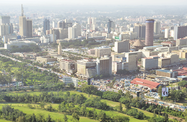A slowdown in agricultural activity, tighter credit conditions, a mid-year spike in inflation and political uncertainty on the back of two disputed elections have contributed to a mixed year for Kenya, with the country scaling down internal growth forecasts.

GDP growth was expected to reach 5% in 2017, down from 5.8% in 2016, but still well above the sub-Saharan average of 2.7%, according to the IMF.
However, proposed credit changes and the Supreme Court’s decision to uphold the results of October’s presidential election point to a more positive outlook for 2018.
Severe weather conditions affect agriculture
A period of drought, followed by flooding, impacted agricultural production and earnings in key segments of the largest economic sector.
Drought was a major factor affecting green tea leaf production, which declined by 12.4% year-on-year (y-o-y) in the first nine months of the year, according to the Agriculture and Food Authority. Yearly yields are expected to total 420m kg, down from the 473m kg recorded in 2016.
Sugar production fell by 29.5% y-o-y, while coffee sales on the Nairobi Coffee Exchange were down 20.1%, as adverse weather conditions affected crop harvests.
As the drought eased in the fourth quarter, heavy rainfall in some parts of the country led to flooding, further hindering the harvest and transport of crops in key areas.
Maize growers in the west were among the hardest hit, with many unable to dry grains ahead of processing. These production losses led to an increase in crop prices, feeding into inflation.
Agriculture is of vital importance in Kenya, meaning that any downturn has a significant impact on the broader economy; the sector employed around 75% of the workforce during the 2015/16 season and accounts for 30% of GDP.
Inflation steadying amid increase in agricultural output
Fluctuations in agricultural activity contributed to an increase in the cost of living, with inflation rising to 11.7% in May 2017.
While this placed a strain on businesses and consumers, more favourable weather conditions and an agricultural rebound led to a decline in inflation in the second half of the year. Indeed, inflation dropped to as low as 4.7% in November, and the Central Bank of Kenya (CBK) has forecast rates of around 5% in 2018.
Large-scale projects spur economic growth
With the performance of agriculture affected by extreme weather events, growth in 2017 was largely supported by expansion in other key sectors.
On the back of a number of large-scale public works projects and increased private investment, the construction sector grew by 7.9% in the first half of 2017. This rate was similar to that seen in mining and quarrying, which expanded by 7.8%, while the transport and storage, and manufacturing sectors grew by 4.9% and 2.5%, respectively.
Political uncertainty impacts economic forecasts
The economic challenges came amid an extended period of political uncertainty, with the re-running of the country’s presidential election seen as a key factor weighing on the broader economy.
Electoral irregularities meant that the results of Kenya’s August 8 presidential election were annulled, driving the country to the polls again on October 26.
The cost of staging successive elections was a factor behind the country’s struggle to meet budgetary targets, and led the government to amend its budget in September to include a series of austerity measures. The Treasury revised its 2017/18 budget deficit projection from 6.8% of GDP to 8.1%.
The concerns over debt led international ratings agency Moody’s to forecast debt-to-GDP levels would rise to 60% by June 2018, up from current levels of 56.4%, and in November it flagged a possible downgrade of Kenya’s credit rating, citing rising debt, and political and investor uncertainty.
Growth forecasts have similarly been affected. In early November Henry Rotich, the minister of finance, revised Kenya’s year-end GDP growth outlook from 5.5% to 5%. However, in a positive sign, the economy is expected to expand by 6% this year and 7% in the medium term.
Relaxing credit restrictions to drive growth
In a further boost for the country’s economic outlook, Patrick Njoroge, the governor of the CBK, has proposed easing credit restrictions on private banks, an issue seen as having limited private sector access to credit.
Introduced in September 2016, the reforms capped commercial lending rates at four percentage points above the central bank rate of 10%, while also imposing a minimum deposit rate of 70%.
The measures have been cited by industry officials as having a significant impact on lending; many of Kenya’s main banks recorded a fall in earnings in the first three quarters of the year and an increase in non-performing loans.
The proposed easing of credit restrictions, along with a more stable political climate, could encourage Kenyan banks to increase rates of lending in the new year, subsequently providing local business with more finance to stimulate growth in the economy.


